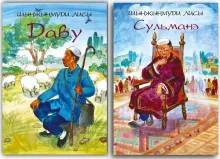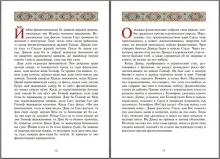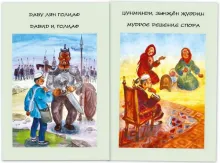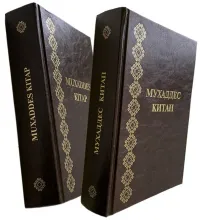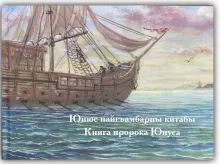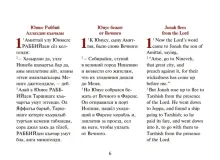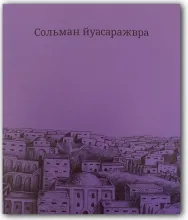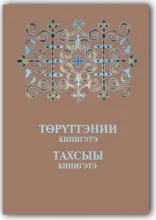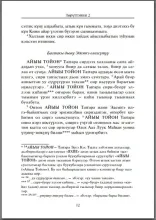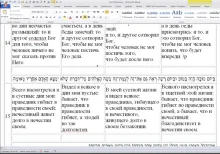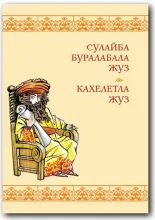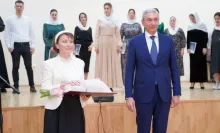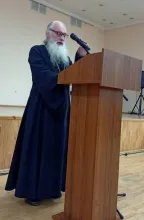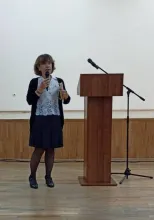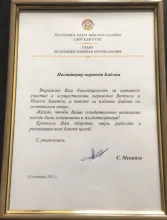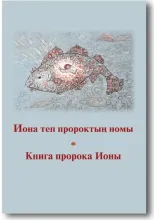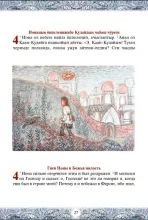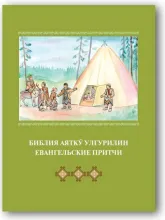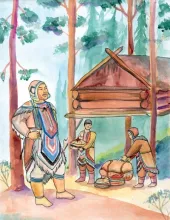news-20032023
The Institute for Bible Translation is continuing its series of short "Stories of the Prophets" in the Dungan language, telling the story of biblical prophets who are revered by Muslims, Christians, and Jews alike. The newest books in the series are David and Solomon. The texts of the Dungan translation are accompanied by a parallel Russian text and colorful illustrations by the Dungan artist Khalida Shimova, who portrayed the biblical characters as closely as possible to the Dungan readers’ worldview, psychology, and way of life.
news-24012023
The Institute for Bible Translation (IBT) has produced the first-ever translation of the complete Bible into the Karakalpak language. The project began in the mid-1990s and was carried out by IBT in partnership with the United Bible Societies and SIL International.
news-20122022
IBT has published a Karachai translation of the book of Jonah. This is the first book of the Old Testament translated by IBT into the Karachai language. Prior to that, the Gospel of Mark (1978) and the Gospel of Luke (1999) were published in Karachai.
The translation of Jonah was published as an illustrated edition with artwork produced by an artist from the Caucasus and with a parallel Russian and English text, the latter for attracting the interest of young Karachais who are learning English.
news-08122022
IBT has published a new book in the Abaza language called Solomon's Wisdom. The Abaza are a people of the Northwestern Caucasus who live primarily in the Karachay-Cherkess and Stavropol areas of southern Russia. The Abaza language belongs to Abkhaz-Adyghe group of Caucasian languages. It is one of the five official languages of the Karachay-Cherkess Republic. According to the 2010 census, the number of Abaza speakers in Russia is about 38,000.
The new edition is a collection of extracts from two Biblical books – 1 Kings and the book of Proverbs. The epigraph to the collection is the quote, "The teaching of the wise is a fountain of life, turning a person from the snares of death" (Proverbs 13:14). It introduces the reader to the central theme of the collection: wisdom. Wisdom belongs to God; it is the moral law of the universe. It is woven into the foundation of things and everything in the world is subject to its laws. Whenever people do good deeds and make good decisions, they live in harmony with wisdom...
news-09112022
The Institute for Bible Translation (IBT) has released Genesis and Exodus in the Yakut language.
The Yakuts (endonym: Sakha) are an indigenous people of eastern Siberia and the Far East region of the Russian Federation. The Yakut language belongs to the Turkic group of languages. According to the 2010 All-Russian population census, it is spoken by about 450,000 people.
Both of these books are distinguished by a variety of literary styles: sometimes it is a solemn narrative, at other times, a long genealogical list, or a beautiful blessing in verse. In order to convey the exact meaning of these two books in modern literary Yakut...
news-14102022
On October 10-14 IBT conducted a webinar for Bible translation teams from IBT and partner organizations on the Old Testament book of Ecclesiastes. 14 participants from seven Bible translation projects (Avar, Kyrgyz, Tabasaran, Khakass, Tsakhur, Yakut and a North Caucasian project) gathered online for this training event. The webinar was taught by Luka Manevich, a biblical scholar and exegetical adviser in several Scripture translation projects, already familiar to many of the students from his expert instruction at previous webinars.
news-04102022
The Institute for Bible Translation (IBT) has released a new publication in Dargi, one of the official languages of the Republic of Dagestan in the Russian Federation. Newspapers, journals, and books are published in this language, and it is studied in school in areas with a large Dargi population. There are altogether about 485,000 speakers of Dargi in Russia.
news-20092022
The presentation of the Bible translated into the Ossetic language was held at the National Scientific Library of the Republic of North Ossetia-Alania in Vladikavkaz on September 20, 2022. This is the first ever complete translation of the Bible into the Iron variant of the Ossetic language, spoken by five-sixths of the Ossetic population (about 600,000 people). This publication is combined the New Testament translated by the Institute for Bible Translation and the Old Testament translated by the Bible Society in Russia. This work took 25 years overall.
news-02092022
The Shors are a minority indigenous people who live in the south of Kemerovo Region (in the Novokuznetsk and Tashtagol areas of Russia) and beyond. According to the 2010 census, they number about 13,000 people. The written alphabet was created in 1927 based on the Russian script. Since that time, a number of school grammars, textbooks, primers, books for reading, several translations of classical Russian literature and a district newspaper were published.
news-07072022
IBT’s Evenki Bible translation project continues with the release of the Gospel Parables edition. I's the seventh IBT Scripture publication in the Evenki language. Previously published works include: excerpts from the Gospel of Luke (1995); Jesus - Friend of Children with a parallel Russian translation (1999); the Gospel of Luke (2002); the Children’s Bible (2011); the Gospel of Luke with a parallel Russian translation (2013), and the book of Jonah with a parallel Russian translation (2018).

